The Expected Dynamics for the Extreme Wind and Wave Conditions at the Mouths of the Danube River in Connection with the Navigation Hazards
Abstract
1. Introduction
2. Materials and Methods
2.1. In Situ Measurements
2.2. Wind Model Data Considered
2.3. Wave Model Simulations
3. Results
3.1. Analysis of the In Situ Measurements
3.2. Analysis of Wind Data Offshore the Danube’s Mouths: Recent Past vs. near Future
3.3. Analysis of Wave Data Offshore the Danube’s Mouths: Recent Past vs. near Future
4. Discussion
- The analysis of the wind data shows that there is in general a good match between the measurements and the model results, especially with regard to the intensity of the maximum wind speeds. However, by comparing Figure 4 and Figure 6, we can notice that in RP0, the dominant wind direction is from north to northwest, while in RP1, it is from north to northeast. Furthermore, unlike in RP0, in RP1, significant winds also come from the southeast, while in both cases, significant winds come from the south. The main explanation for these differences is that while RP1 is located 30 km offshore, RP0 represents the zero-kilometer point of the Danube, where both the influence of the coast and the local wind currents propagating along the river are more consistent.
- With regard to the waves, the results show that we can expect significant wave heights that are even higher than 7 m in the coastal environment offshore the mouths of the Danube River. Furthermore, as Figure 14 clearly illustrates, the local processes and especially the wave–current interactions and the shallow water effects induce considerable enhancements in the wave height in the nearshore. From this perspective and in order to assess better the influence of the local effects at the entrance to the Sulina channel, wave model simulations were carried out considering the most common wave patterns from the point of view of the significant wave height (Hso) and the mean wave direction of the incoming waves on the offshore boundary (Wdir), as indicated by Figure 15, Figure 16, Figure 19 and Figure 20. Furthermore, previous results in terms of the wave modeling presented in reference [48] were also considered. Thus, in the high-resolution computational domain described in Table 1, SWAN simulations were performed considering significant wave heights and wave directions in the ranges of [1–5 m] and [30°–150°]. Based on the results of these simulations, an index giving the relative enhancement in the significant wave height at the entrance to the Sulina channel due to the wave–current interactions (REHs) was evaluated. The expression of this index is given by the equation below, while the corresponding values are provided in Table 4.
5. Conclusions
Author Contributions
Funding
Institutional Review Board Statement
Informed Consent Statement
Data Availability Statement
Acknowledgments
Conflicts of Interest
Nomenclature
| ALADIN | Aire Limitée Adaptation dynamique Développement International |
| ARPEGE | Action de Recherche Petite Echelle Grande Echelle |
| BFI | Benjamin–Feir index (or the steepness-over-randomness ratio) |
| CERFACS | Centre Européen de Recherche et Formation Avancée en Calcul Scientifique |
| CNRM | Centre National de Recherches Météorologiques |
| ECMWF | European Centre for Medium-Range Weather Forecasts |
| ERA | ECMWF re-analysis |
| LR | Low resolution (and also indicates linear regression in the case of the annual maximum series) |
| Hs | Significant wave height |
| Hsmax | Maximum value of the significant wave height |
| Hso | Offshore value of the significant wave height in the high-resolution computational domain |
| MPI-M | Max Planck Institute for Meteorology |
| MPI-ESM | Max-Planck-Institute Earth System Model |
| Qp | Peakedness of the wave spectrum |
| R | Correlation coefficient |
| RCA4 | Rossby Centre regional atmospheric model, version 4 |
| RCM | Regional climate model |
| RCP | Representative concentration pathway |
| RCSM | Regional climate system model |
| REHs | Relative enhancement of the significant wave height due to the wave–current interactions |
| RMSE | Root mean square error |
| RP0 | Reference point zero (zero-kilometer point of the Danube River) |
| RP1 | Reference point 1 (for wind and wave model data offshore the Sulina channel) |
| RP2 | Reference point 2 (for wind and wave model data offshore the Sain George arm of the Danube) |
| S | Regression slope |
| SI | Scatter index |
| SMHI | Swedish Meteorological and Hydrological Institute |
| SSP | Shared Socioeconomic Pathway |
| St | Integral wave steepness |
| SWAN | Simulating waves nearshore |
| U10 | Wind speed at 10 m above the sea level provided by the model |
| Uw | Measured wind speed |
| Uwg | Maximum value of the wind gust |
| WAM | Wave model |
| Wdir | Mean wave direction of the incoming waves on the offshore boundary of the computational domain |
| WW3 | Wave Watch 3 |
| Longitude | |
| Latitude |
References
- United Nations. Report of the Conference of the Parties to the United Nations Framework Convention on Climate Change (21st Session); United Nations: Paris, France, 2015; Volume 4, p. 2017. [Google Scholar]
- Moss, R.H.; Edmonds, J.A.; Hibbard, K.A.; Manning, M.R.; Rose, S.K.; Van Vuuren, D.P.; Carter, T.R.; Emori, S.; Kainuma, M.; Kram, T.; et al. The next generation of scenarios for climate change research and assessment. Nature 2010, 463, 747–756. [Google Scholar] [CrossRef] [PubMed]
- Schleussner, C.-F. The Paris Agreement—The 1.5 °C Temperature Goal. Climate Analytics, January 2022. [Google Scholar]
- IPCC. Managing the Risks of Extreme Events and Disasters to Advance Climate Change Adaptation; Field, C.B., Ed.; A Special Report of Working Groups I and II of the Intergovernmental Panel on Climate Change; Cambridge University Press: Cambridge, UK; New York, NY, USA, 2012; p. 582. [Google Scholar]
- Toimil, A.; Losada, I.J.; Nicholls, R.J.; Dalrymple, R.A.; Stive, M.J.F. Addressing the challenges of climate change risks and adaptation in coastal areas: A review. Coast. Eng. 2020, 156, 103611. [Google Scholar] [CrossRef]
- Rusu, E. A 30-year projection of the future wind energy resources in the coastal environment of the Black Sea. Renew. Energy 2019, 139, 228–234. [Google Scholar] [CrossRef]
- Negm, A.; Zaharia, L.; Toroimac, G.I. The Lower Danube River Hydro-Environmental Issues and Sustainability; Springer: Berlin/Heidelberg, Germany, 2022; ISBN 978-3-031-03864-8. [Google Scholar]
- Răileanu, A.B.; Rusu, L.; Rusu, E. An Evaluation of the Dynamics of Some Meteorological and Hydrological Processes along the Lower Danube. Sustainability 2023, 15, 6087. [Google Scholar] [CrossRef]
- ShipTraffic.net, River Discharge and Related Historical Data from the European Flood Awareness System. Available online: http://www.shiptraffic.net/2001/04/danube-river-ship-traffic.html?full_screen=yes&map=vf (accessed on 12 February 2024).
- Stagl, J.C.; Hattermann, F.F. Impacts of Climate Change on Riverine Ecosystems: Alterations of Ecologically Relevant Flow Dynamics in the Danube River and Its Major Tributaries. Water 2016, 8, 566. [Google Scholar] [CrossRef]
- Maternová, A.; Materna, M.; Dávid, A. Revealing Causal Factors Influencing Sustainable and Safe Navigation in Central Europe. Sustainability 2022, 14, 2231. [Google Scholar] [CrossRef]
- Galati Lower Danube River Administration, A.A. Available online: https://www.afdj.ro/en/content/ship-statistics (accessed on 12 February 2024).
- Rouholahnejad Freund, E.; Abbaspour, K.C.; Lehmann, A. Water Resources of the Black Sea Catchment under Future Climate and Landuse Change Projections. Water 2017, 9, 598. [Google Scholar] [CrossRef]
- Ivan, A.; Gasparotti, C.; Rusu, E. Influence of the interactions between waves and currents on the navigation at the entrance of the Danube delta. Protection and Sustainable Management of the Black Sea Ecosystem, Special Issue. J. Environ. Prot. Ecol. 2012, 13, 1673–1682. [Google Scholar]
- Stanica, A.; Panin, N. Present evolution and future predictions for the deltaic coastal zone between the Sulina and Sf. Gheorghe Danube River mouths. Geomorphology 2009, 107, 41–46. [Google Scholar] [CrossRef]
- Banescu, A.; Arseni, M.; Georgescu, L.P.; Rusu, E.; Iticescu, C. Evaluation of different simulation methods for analyzing flood scenarios in the Danube Delta. Appl. Sci. 2020, 10, 8327. [Google Scholar] [CrossRef]
- Arseni, M.; Roșu, A.; Bocăneală, C.; Constantin, D.-E.; Georgescu, P.L. Flood hazard monitoring using GIS and remote sensing observations. Carpathian J. Earth Environ. Sci. 2017, 12, 329–334. [Google Scholar]
- Onea, F.; Rusu, E. Wind energy assessments along the Black Sea basin. Meteorol. Appl. 2014, 21, 316–329. [Google Scholar] [CrossRef]
- Bernardino, M.; Rusu, L.; Guedes Soares, C. Evaluation of extreme storm waves in the Black Sea. J. Oper. Oceanogr. 2021, 14, 114–128. [Google Scholar] [CrossRef]
- Rusu, E. Modeling of wave-current interactions at the Danube’s mouths. J. Mar. Sci. Technol. 2010, 15, 143–159. [Google Scholar] [CrossRef]
- Lazar, L.; Rodino, S.; Pop, R.; Tiller, R.; D’Haese, N.; Viaene, P.; De Kok, J.-L. Sustainable Development Scenarios in the Danube Delta—A Pilot Methodology for Decision Makers. Water 2022, 14, 3484. [Google Scholar] [CrossRef]
- Novac, V.; Stavarache, G.; Rusu, E. Naval accidents causative factors—A Black Sea case study. Int. Multidiscip. Sci. GeoConference Surv. Geol. Min. Ecol. Manag. SGEM 2021, 21, 551–559. [Google Scholar]
- Booij, N.; Ris, R.; Holthuijsen, L. A third generation wave model for coastal regions. Part 1: Model description and validation. J. Geophys. Res. 1999, 104, 7649–7666. [Google Scholar] [CrossRef]
- ICPDR 2004, Danube Basin Analysis, WDF Report 2004. Available online: https://www.icpdr.org/sites/default/files/nodes/documents/danube_basin_analysis_2004.pdf (accessed on 2 December 2023).
- Poncos, V.; Teleaga, D.; Bondar, C.; Oaie, G. A new insight on the water level dynamics of the Danube Delta using a high spatial density of SAR measurements. J. Hydrol. 2013, 482, 79–91. [Google Scholar] [CrossRef]
- Bajo, M.; Ferrarin, C.; Dinu, I.; Umgiesser, G.; Stanica, A. The water circulation near the Danube Delta and the Romanian coast modelled with finite elements. Cont. Shelf Res. 2014, 78, 62–74. [Google Scholar] [CrossRef]
- Romanian National Authority of Meteorology. 2024. Available online: https://www.meteoromania.ro/servicii/date-meteorologice/ (accessed on 14 September 2023).
- ERA5/ECMWF. Available online: https://www.ecmwf.int/en/forecasts/datasets/reanalysis-datasets/era5 (accessed on 22 January 2024).
- Giorgetta, M.A.; Jungclaus, J.; Reick, C.H.; Legutke, S.; Bader, J.; Böttinger, M.; Brovkin, V.; Crueger, T.; Esch, M.; Fieg, K.; et al. Climate and carbon cycle changes from 1850 to 2100 in MPI-ESM simulations for the Coupled Model Intercomparison Project phase 5. J. Adv. Model. Earth Syst. 2013, 5, 572–597. [Google Scholar] [CrossRef]
- Giorgetta, M.; Jungclaus, J.; Reick, C.; Legutke, S.; Brovkin, V.; Crueger, T.; Esch, M.; Fieg, K.; Glushak, K.; Gayler, V.; et al. CMIP5 Simulations of the Max Planck Institute for Meteorology (MPI-M) Based on the MPI-ESM-LR Model: The piControl Experiment, Served by ESGF. World Data Center for Climate (WDCC) at DKRZ; PCMDI: San Francisco, CA, USA, 2012. [Google Scholar] [CrossRef]
- COPERNICUS Database. Available online: https://cds.climate.copernicus.eu/cdsapp#!/dataset/projections-cordex-domains-single-levels?tab=form (accessed on 12 September 2023).
- Nabat, P.; Somot, S.; Cassou, C.; Mallet, M.; Michou, M.; Bouniol, D.; Decharme, B.; Drugé, T.; Roehrig, R.; Saint-Martin, D. Modulation of radiative aerosols effects by atmospheric circulation over the Euro-Mediterranean region. Atmos. Chem. Phys. 2020, 20, 8315–8349. [Google Scholar] [CrossRef]
- Roehrig, R.; Beau, I.; Saint-Martin, D.; Alias, A.; Decharme, B.; Guérémy, J.; Voldoire, A.; Abdel-Lathif, A.Y.; Bazile, E.; Belamari, S.; et al. The cnrm globalatmosphere model arpege-climat 6.3: Description and evaluation. J. Adv. Model. Earth Syst. 2020, 12, e2020MS002075. [Google Scholar] [CrossRef]
- Darmaraki, S.; Somot, S.; Sevault, F.; Nabat, P. Past variability of Mediterranean Sea marine heatwaves. Geophys. Res. Lett. 2019, 46, 9813–9823. [Google Scholar] [CrossRef]
- CNRM 2023. Available online: https://www.umr-cnrm.fr/spip.php?article1098&lang=fr (accessed on 14 March 2023).
- Holthuijsen, H. Waves in Oceanic and Coastal Waters; Cambridge University Press: Cambridge, UK, 2007; p. 387. [Google Scholar]
- Rusu, E. Strategies in using numerical wave models in ocean/coastal applications. J. Mar. Sci. Technol. 2011, 19, 58–75. [Google Scholar] [CrossRef]
- WAMDI Group. The WAM model—A third generation ocean wave prediction model. J. Phys. Oceanogr. 1988, 18, 1775–1810. [CrossRef]
- Tolman, H.L. A third-generation model for wind waves on slowly varying, unsteady and inhomogeneous depths and currents. J. Phys. Oceanogr. 1991, 21, 782–797. [Google Scholar] [CrossRef]
- Rusu, L.; Bernardino, M.; Guedes Soares, C. Wind and wave modelling in the Black Sea. J. Oper. Oceanogr. 2014, 7, 520. [Google Scholar] [CrossRef]
- Rusu, E. Reliability and Applications of the Numerical Wave Predictions in the Black Sea. Front. Mar. Sci. 2016, 3, 95. [Google Scholar] [CrossRef]
- Rusu, E. Study of the Wave Energy Propagation Patterns in the Western Black Sea. Appl. Sci. 2018, 8, 993. [Google Scholar] [CrossRef]
- Rusu, E. An analysis of the storm dynamics in the Black Sea. Ro. J. Techn. Sci. Appl. Mech. 2018, 63, 127–142. [Google Scholar]
- Rusu, L. Assessment of the Wave Energy in the Black Sea Based on a 15-Year Hindcast with Data Assimilation. Energies 2015, 8, 1037010388. [Google Scholar] [CrossRef]
- Rusu, L. A projection of the expected wave power in the Black Sea until the end of the 21st century. Renew. Energy 2020, 160, 136–147. [Google Scholar] [CrossRef]
- Yan, X.; Su, X. Linear Regression Analysis: Theory and Computing; World Scientific: Singapore, 2009; pp. 1–2. ISBN 9789812834119. [Google Scholar]
- Rusu, L.; Butunoiu, D.; Rusu, E. Analysis of the extreme storm events in the Black Sea considering the results of a ten-year wave hindcast. J. Environ. Prot. Ecol. 2014, 15, 445–454. [Google Scholar]
- Rusu, E.; Soares, C.G. Modelling the effect of wave current interaction at the mouth of the Danube river. In Developments in Maritime Transportation and Exploitation of Sea Resources; CRC Press, Taylor & Francis Group: London, UK, 2013; pp. 979–986. [Google Scholar]
- Nayaka, S.; Panchangb, V. A Note on Short-term Wave Height Statistics. Aquat. Procedia 2015, 4, 274–280. [Google Scholar] [CrossRef]
- Longuuet-Higgins, M.S. On the Statistical Distribution of the Heights of Sea Waves. J. Mar. Res. 1952, 11, 245–265. [Google Scholar]
- Janssen, P.A.E.M. Nonlinear four-wave interactions and freak waves. J. Phys. Oceanogr. 2003, 33, 863–883. [Google Scholar] [CrossRef]

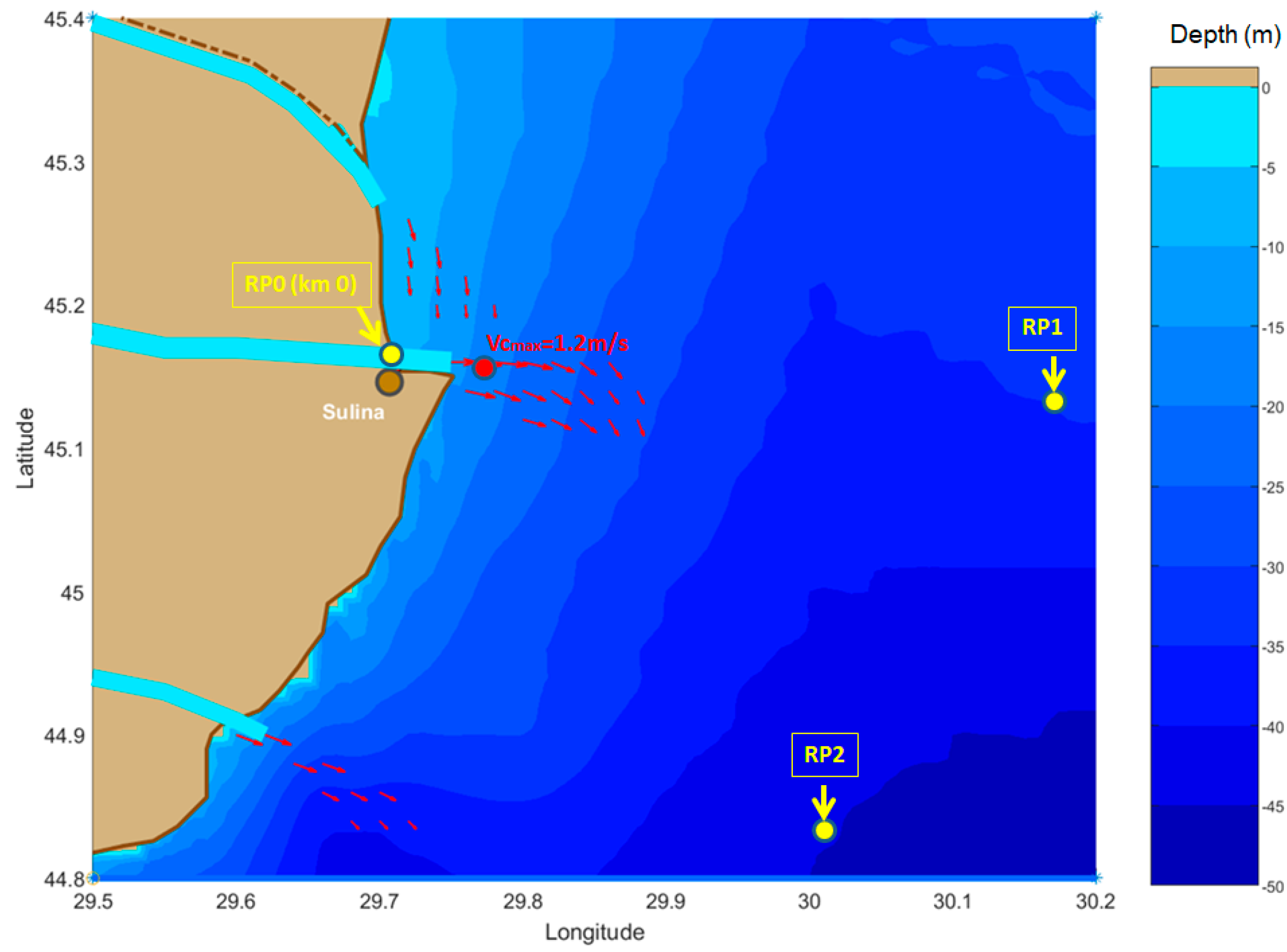
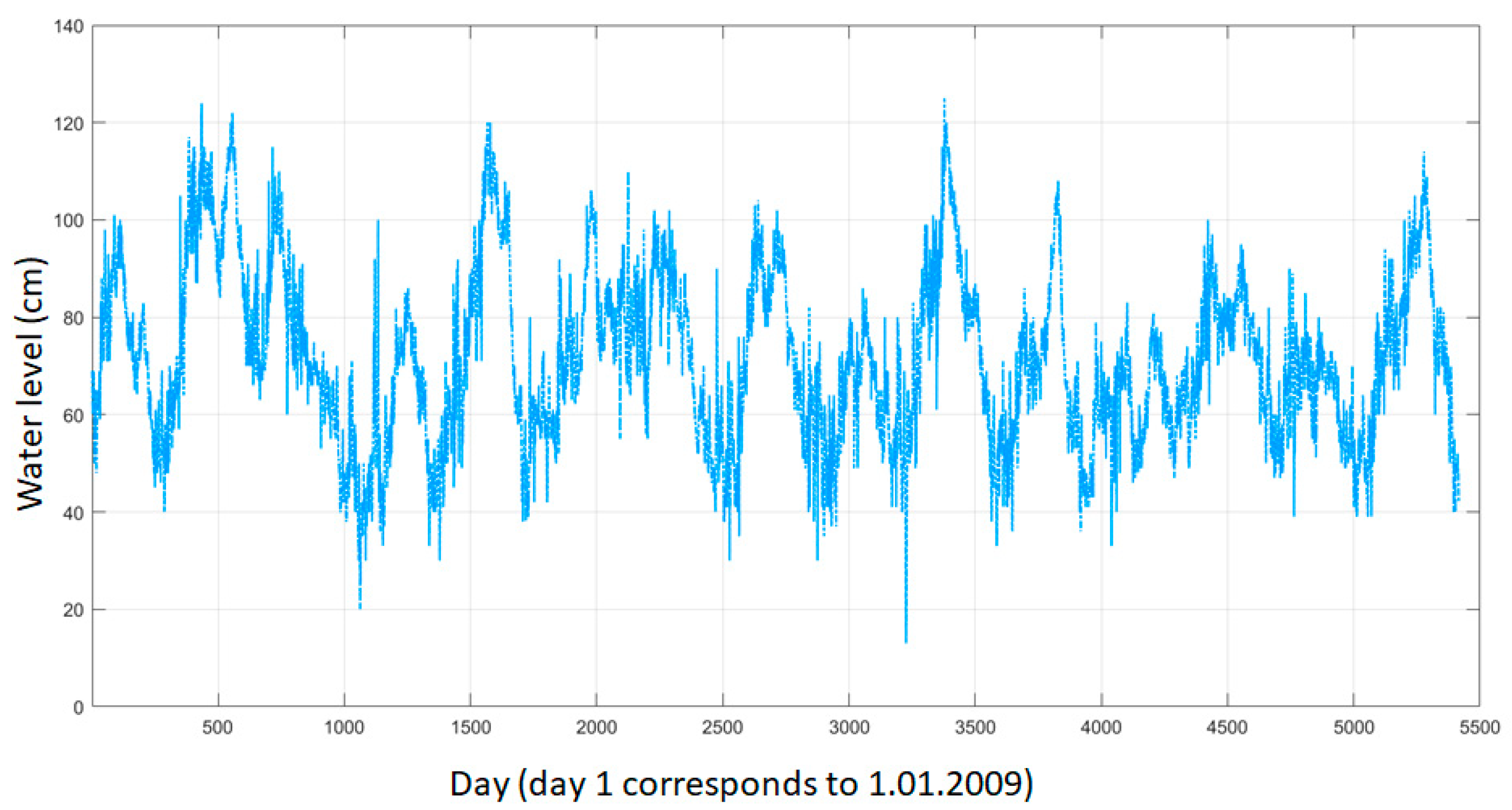

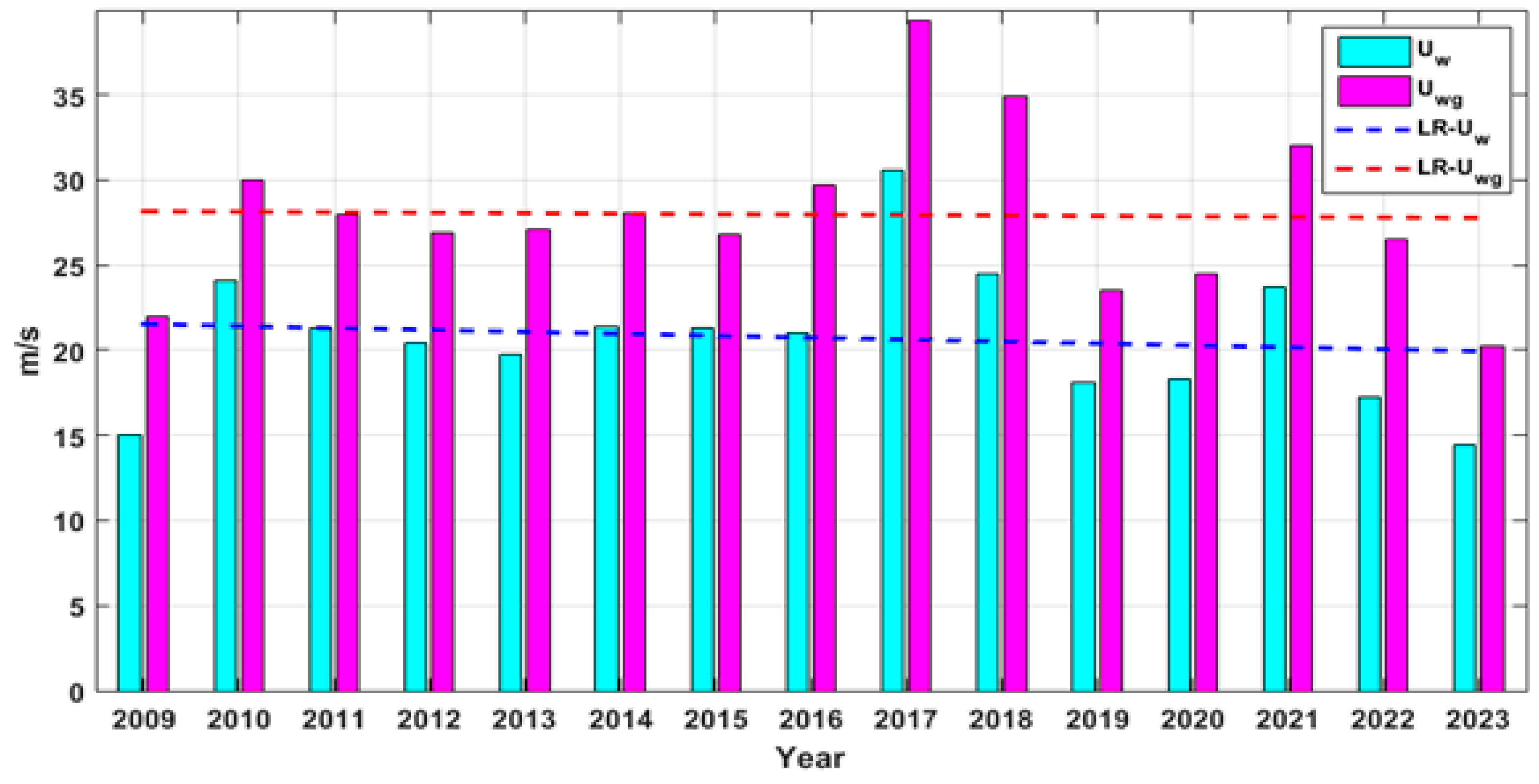

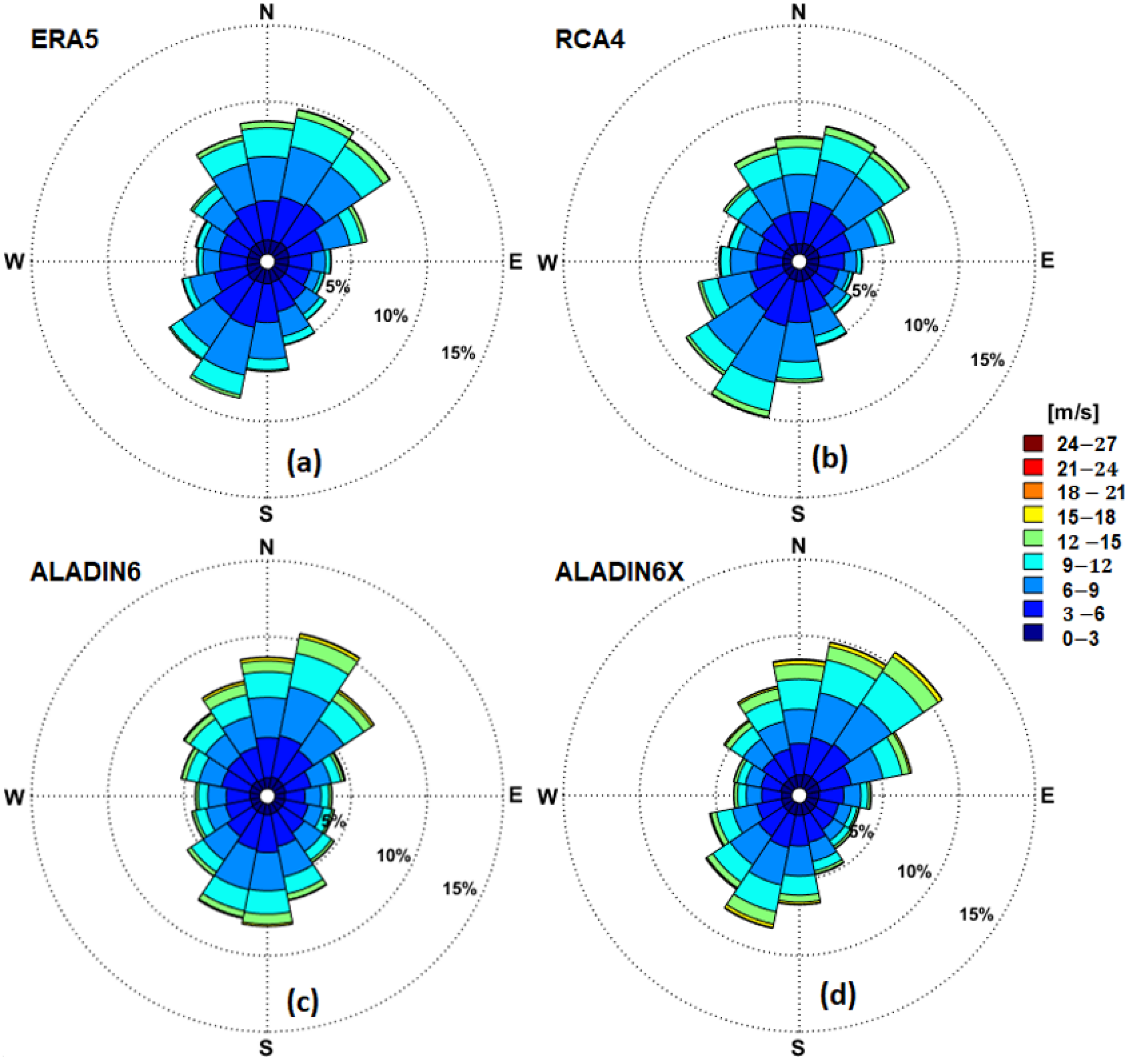
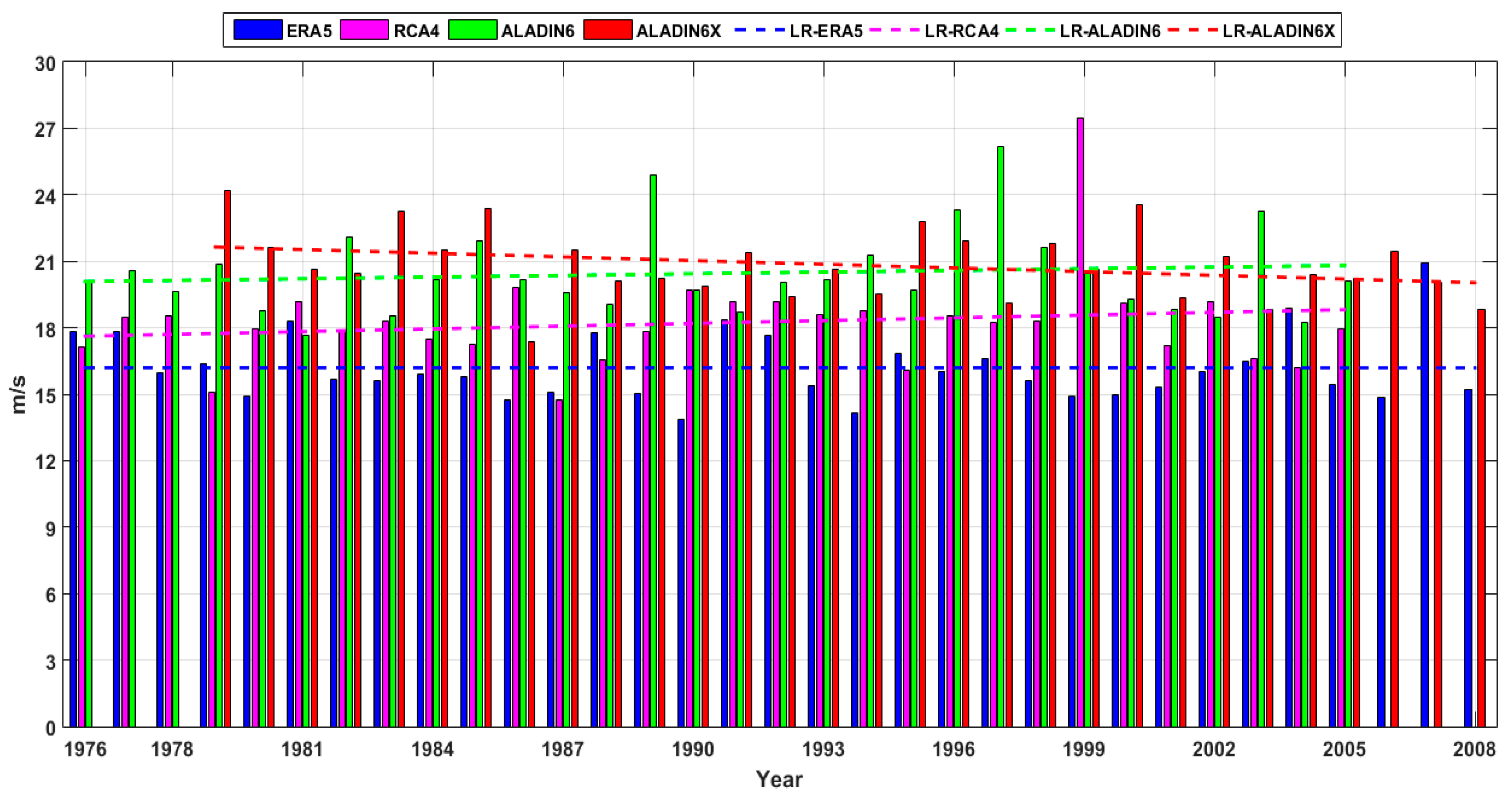



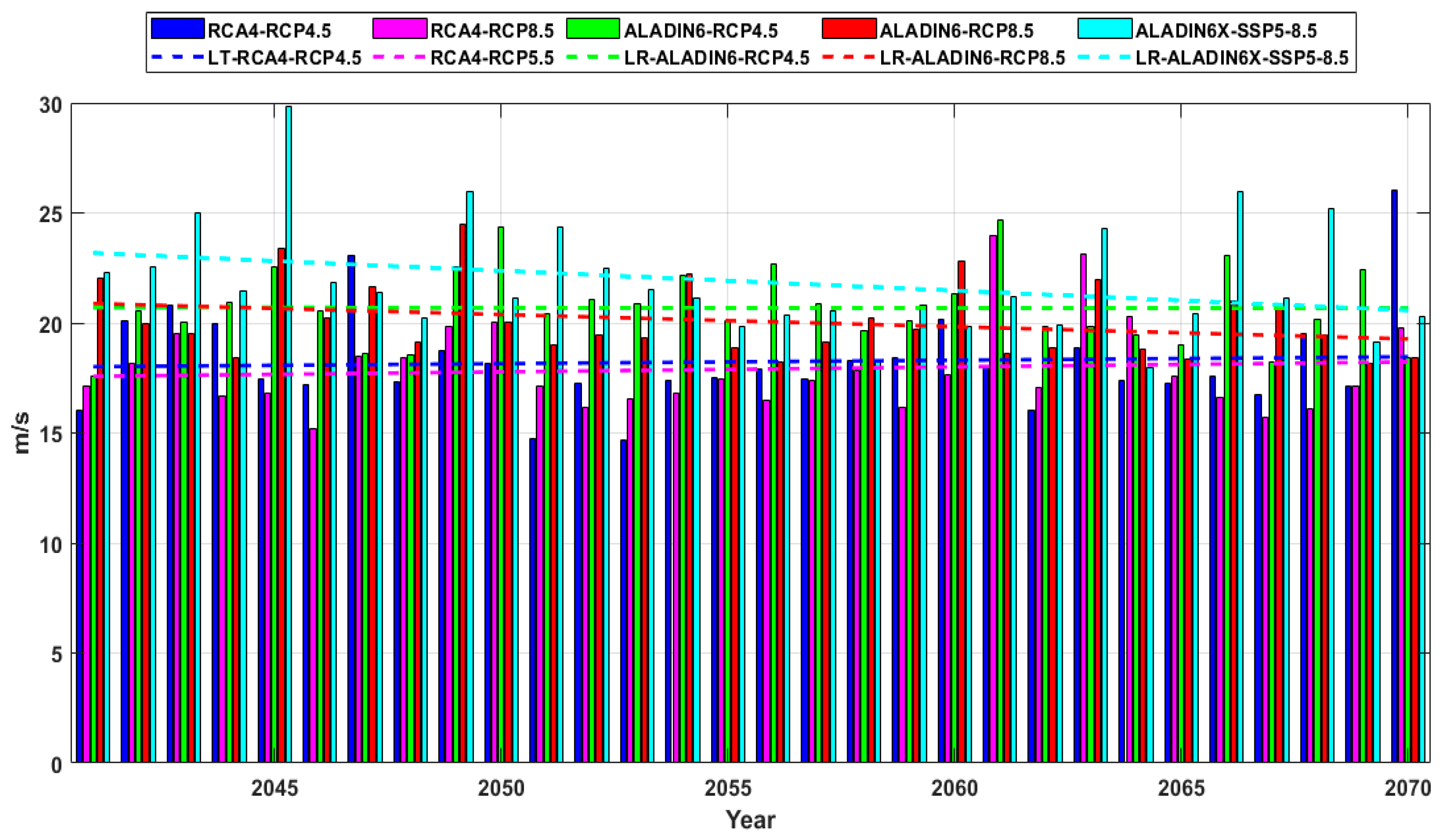

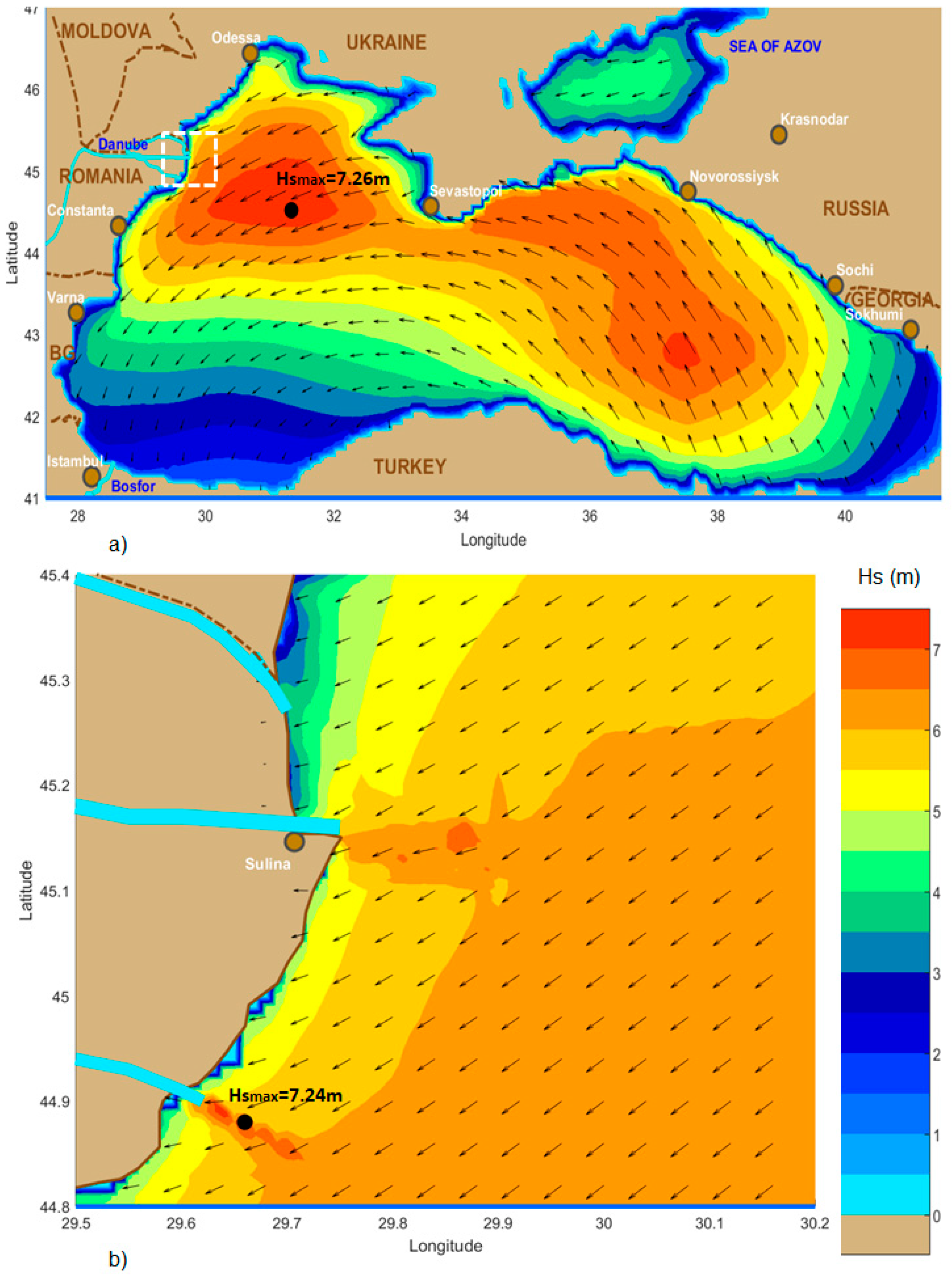
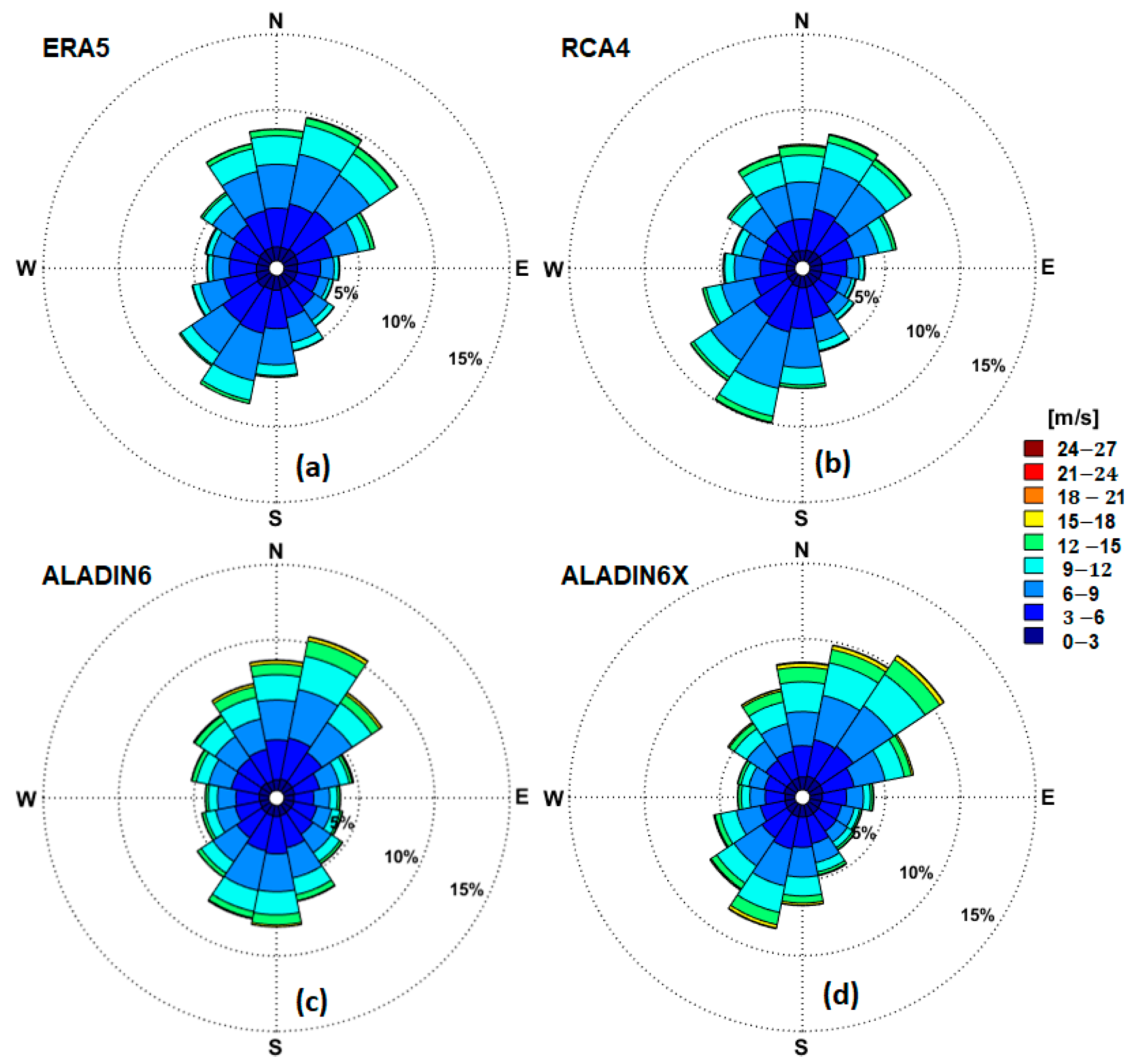
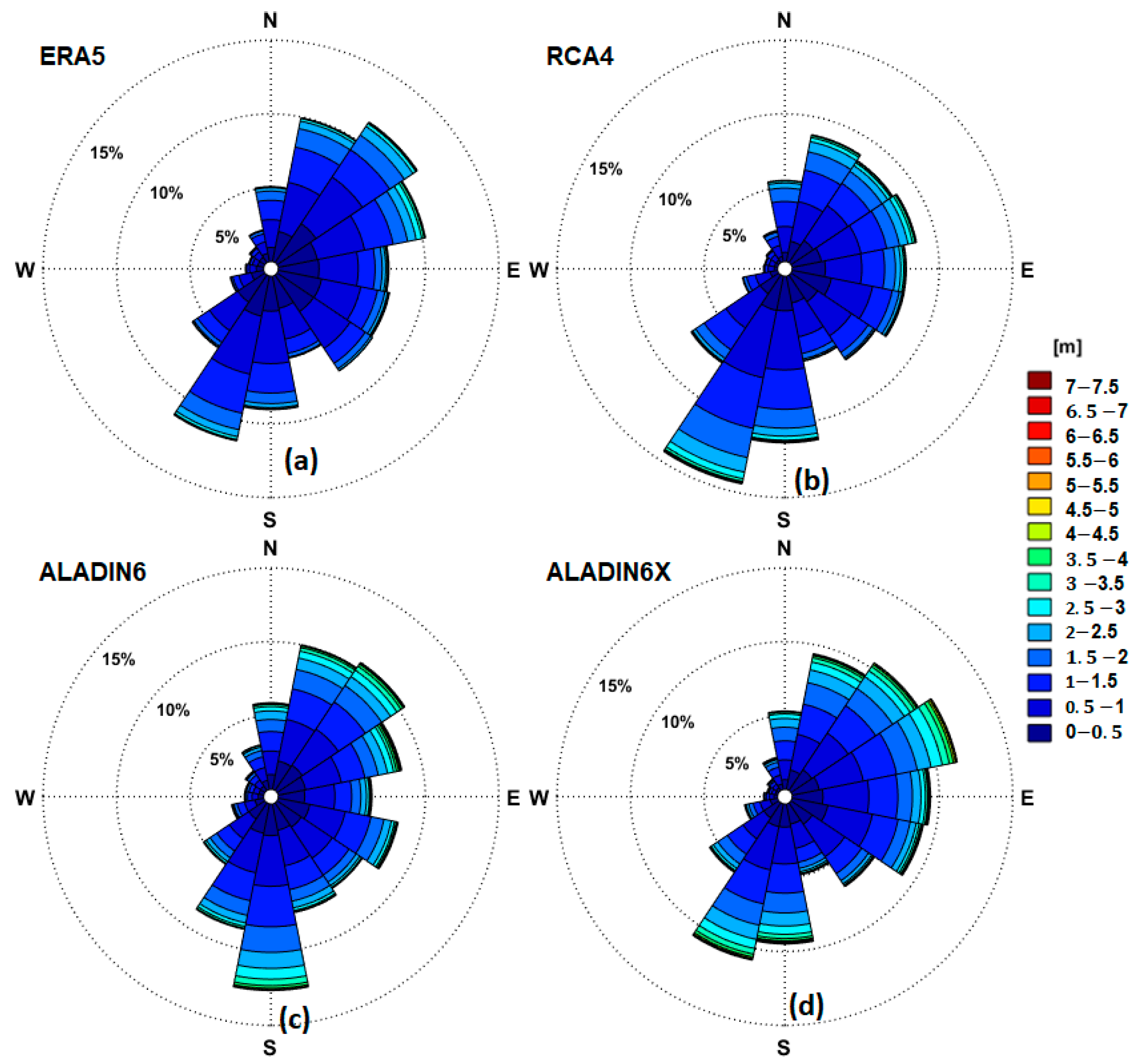
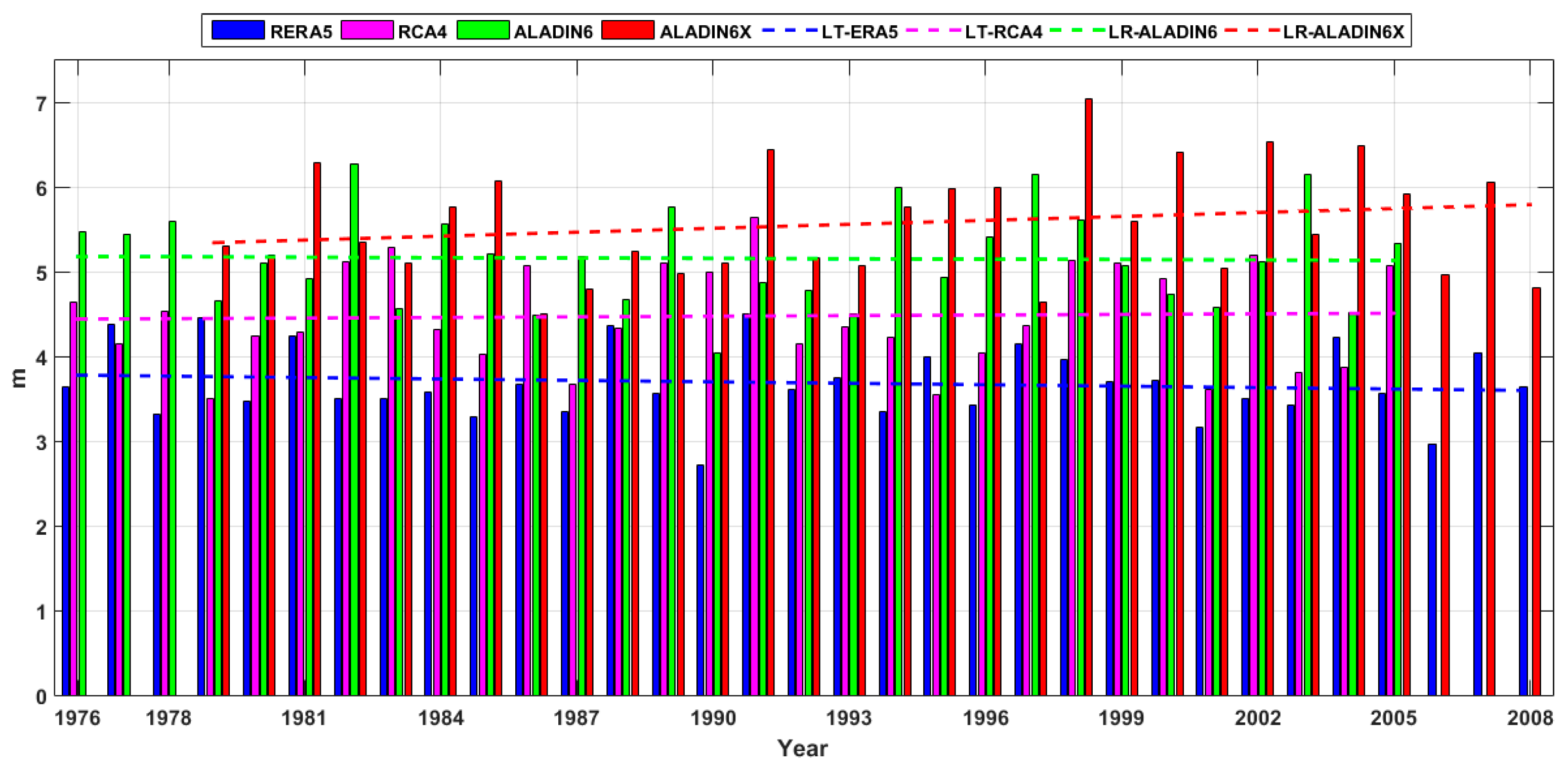
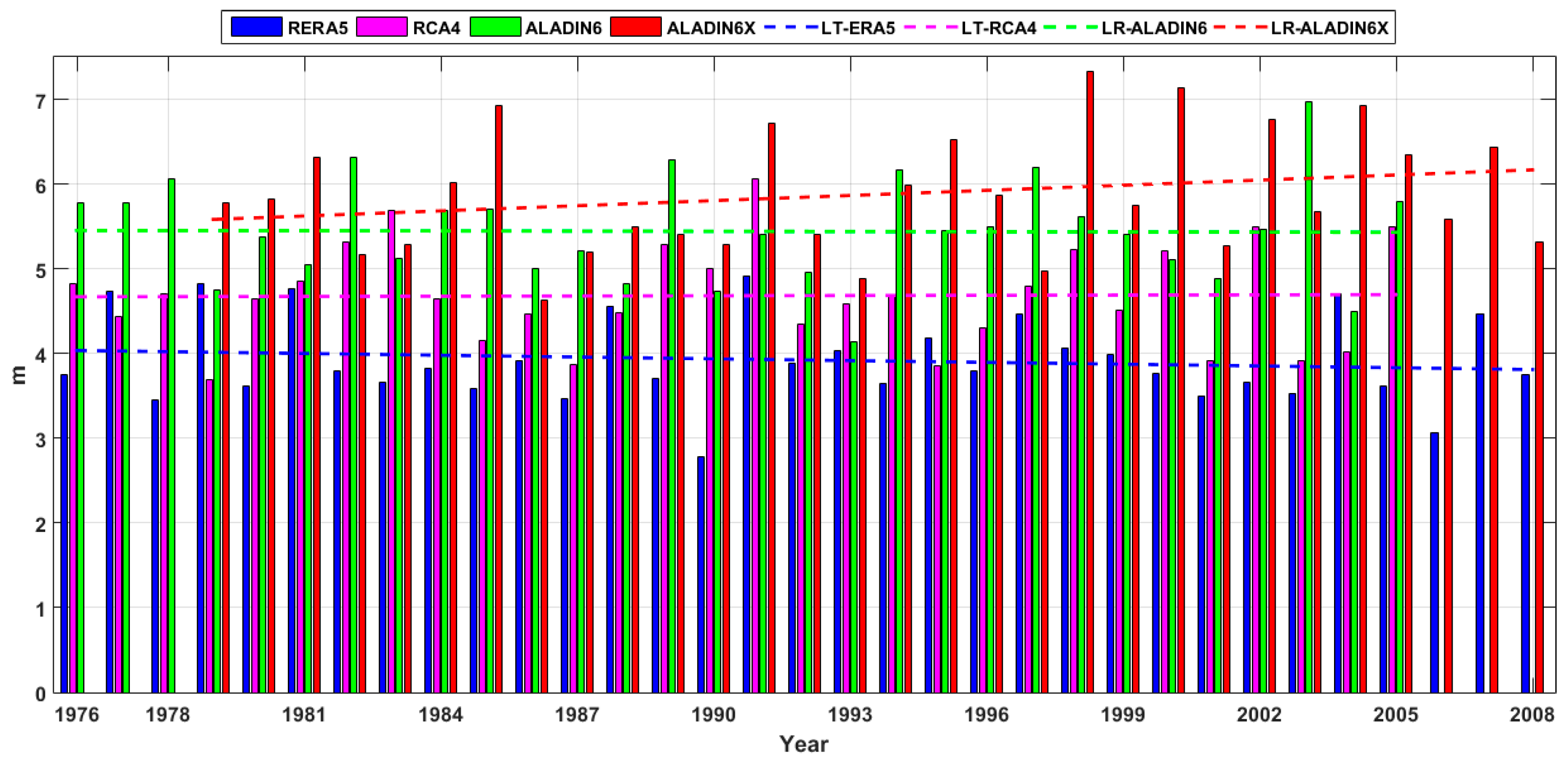
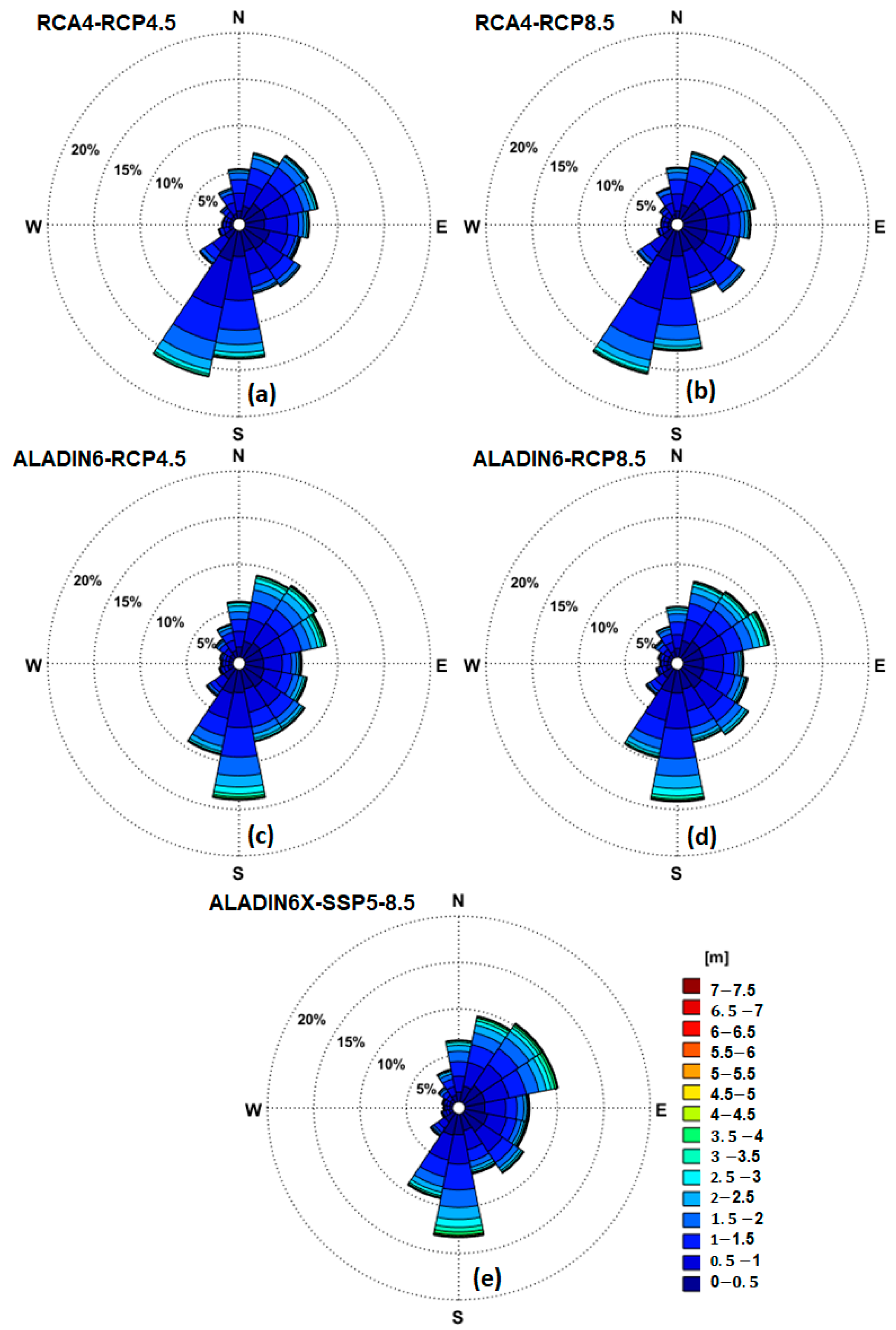

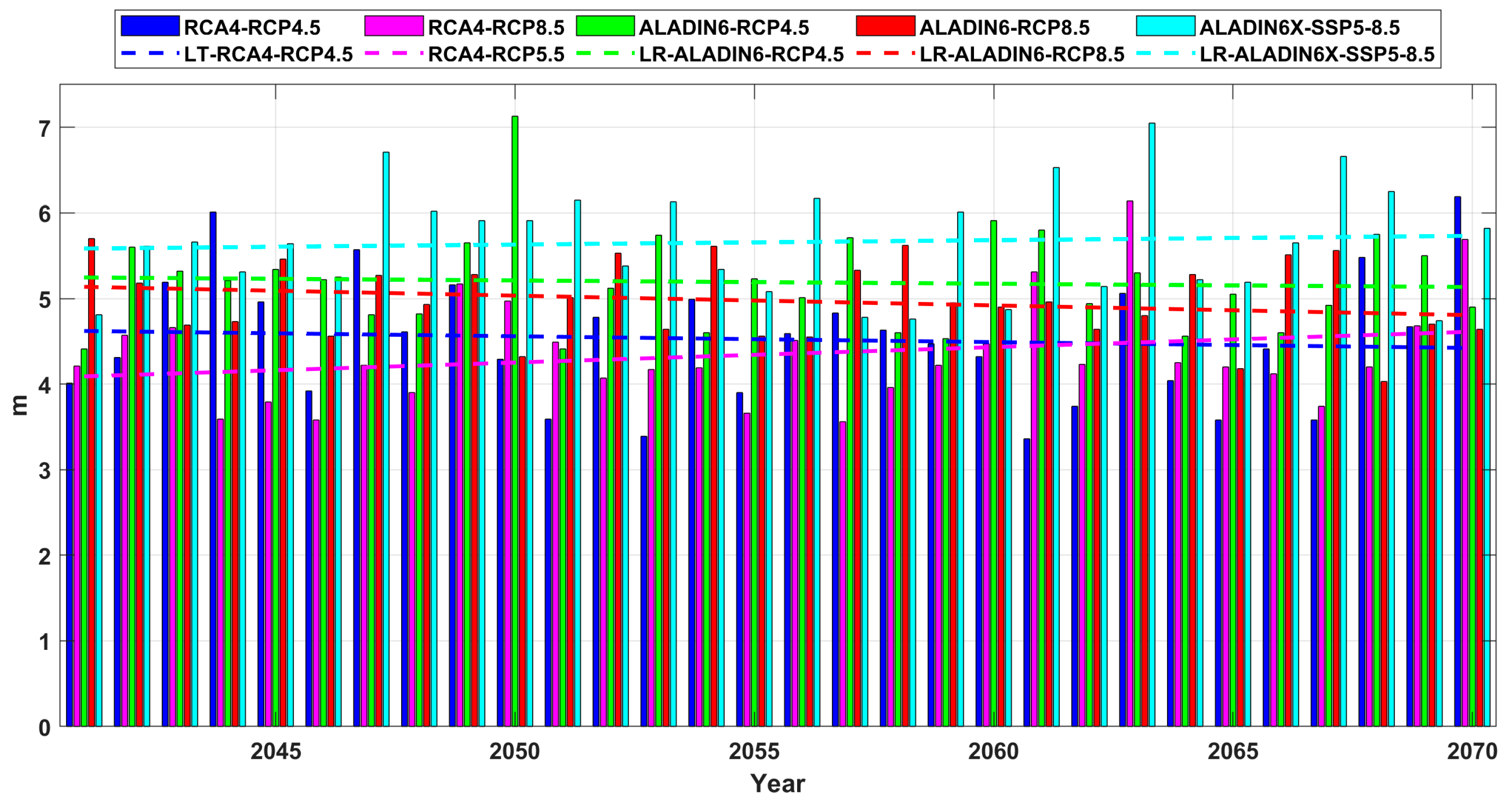
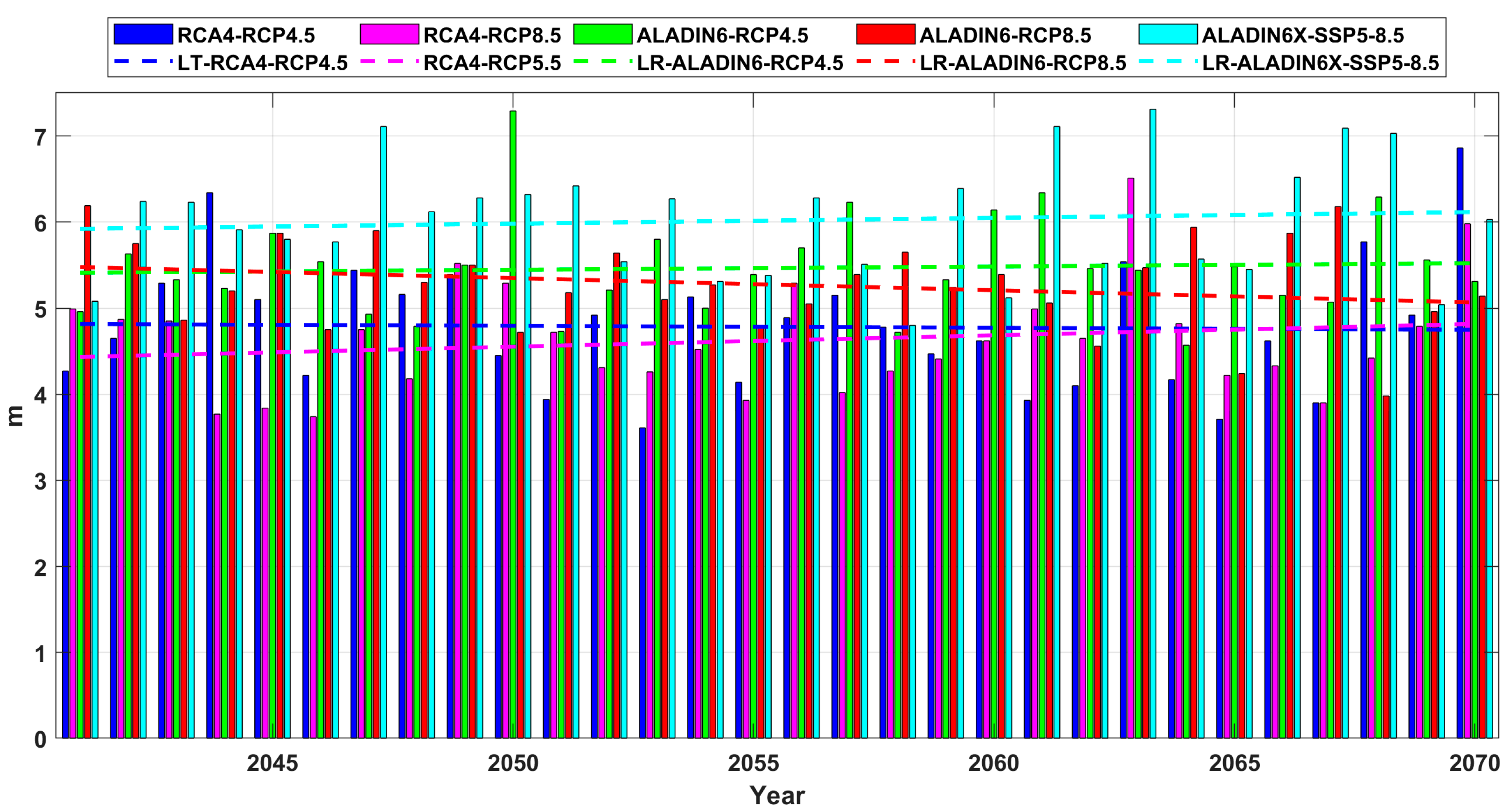

| Spherical Domains | Δλ × Δφ | Δt (min) | nf | nθ | ngλ × ngφ = np |
|---|---|---|---|---|---|
| Sph1—Black Sea | 0.08° × 0.08° | 10 non-stat | 24 | 36 | 176 × 76 = 13,376 |
| Sph2—Danube mouths | 0.01° × 0.01° | 10 non-stat | 24 | 36 | 71 × 61 = 4331 |
| Cartesian Domain | Δx ×Δy (m) | Δt (min) | nf | nθ | ngx × ngy = np |
| Cart—Sulina | 50 × 50 | 60 stat | 30 | 36 | 135 × 216 = 29,160 |
| Input/Process | Wave | Wind | Tide | Curr | Gen | Wcap | Quad | Triad | Diffr | Bfric | Set Up | Br |
|---|---|---|---|---|---|---|---|---|---|---|---|---|
| Domains | ||||||||||||
| Sph1 | 0 | X | 0 | 0 | X | X | X | 0 | 0 | X | 0 | X |
| Sph2 | X | X | 0 | X | X | X | X | X | 0 | X | 0 | X |
| Cart | X | X | 0 | X | X | X | X | X | X | X | X | X |
| Month | Jan | Feb | Mar | Apr | May | Jun | Jul | Aug | Sep | Oct | Nov | Dec |
|---|---|---|---|---|---|---|---|---|---|---|---|---|
| Uw (m/s) | 30.6 | 24.1 | 17.2 | 21.0 | 16.9 | 16.7 | 20.7 | 17.6 | 18.3 | 18.4 | 18.2 | 21.4 |
| Uwg (m/s) | 39.4 | 32.0 | 22.4 | 27.3 | 21.2 | 24.0 | 23.9 | 23.0 | 23.3 | 25.6 | 24.2 | 30.0 |
| Uwg/Uw | 1.29 | 1.33 | 1.30 | 1.30 | 1.25 | 1.44 | 1.16 | 1.31 | 1.27 | 1.39 | 1.33 | 1.40 |
| Hso (m) | Wdir (°) | |||||||||
|---|---|---|---|---|---|---|---|---|---|---|
| 30 | 60 | 90 | 120 | 150 | ||||||
| REHs (%) | BFI | REHs (%) | BFI | REHs (%) | BFI | REHs (%) | BFI | REHs (%) | BFI | |
| 1 | 23 | 0.7 | 30 | 0.8 | 38 | 0.9 | 42 | 0.94 | 38 | 0.85 |
| 2 | 17.5 | 1.2 | 25 | 1.5 | 36.5 | 1.75 | 38.5 | 1.4 | 27.5 | 1.3 |
| 3 | 11 | 1.2 | 18.6 | 1.6 | 32.5 | 1.9 | 35 | 1.7 | 20.7 | 1.4 |
| 4 | 8.25 | 1.1 | 15 | 1.5 | 30 | 1.8 | 31.75 | 1.6 | 17.75 | 1.4 |
| 5 | 6 | 0.9 | 12.8 | 1.4 | 23.4 | 1.7 | 24.2 | 1.5 | 13.6 | 1.3 |
Disclaimer/Publisher’s Note: The statements, opinions and data contained in all publications are solely those of the individual author(s) and contributor(s) and not of MDPI and/or the editor(s). MDPI and/or the editor(s) disclaim responsibility for any injury to people or property resulting from any ideas, methods, instructions or products referred to in the content. |
© 2024 by the authors. Licensee MDPI, Basel, Switzerland. This article is an open access article distributed under the terms and conditions of the Creative Commons Attribution (CC BY) license (https://creativecommons.org/licenses/by/4.0/).
Share and Cite
Răileanu, A.B.; Rusu, L.; Marcu, A.; Rusu, E. The Expected Dynamics for the Extreme Wind and Wave Conditions at the Mouths of the Danube River in Connection with the Navigation Hazards. Inventions 2024, 9, 41. https://doi.org/10.3390/inventions9020041
Răileanu AB, Rusu L, Marcu A, Rusu E. The Expected Dynamics for the Extreme Wind and Wave Conditions at the Mouths of the Danube River in Connection with the Navigation Hazards. Inventions. 2024; 9(2):41. https://doi.org/10.3390/inventions9020041
Chicago/Turabian StyleRăileanu, Alina Beatrice, Liliana Rusu, Andra Marcu, and Eugen Rusu. 2024. "The Expected Dynamics for the Extreme Wind and Wave Conditions at the Mouths of the Danube River in Connection with the Navigation Hazards" Inventions 9, no. 2: 41. https://doi.org/10.3390/inventions9020041
APA StyleRăileanu, A. B., Rusu, L., Marcu, A., & Rusu, E. (2024). The Expected Dynamics for the Extreme Wind and Wave Conditions at the Mouths of the Danube River in Connection with the Navigation Hazards. Inventions, 9(2), 41. https://doi.org/10.3390/inventions9020041










